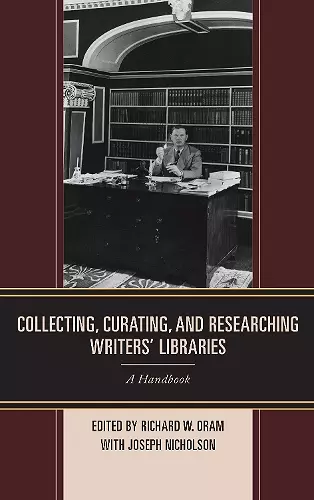Collecting, Curating, and Researching Writers' Libraries
A Handbook
Joseph Nicholson author Richard W Oram editor
Format:Hardback
Publisher:Rowman & Littlefield
Published:21st May '14
Currently unavailable, and unfortunately no date known when it will be back

Academic collection practices in recent years have extended to the private libraries of notable individual authors. As a consequence, book historians have become more interested in the study of provenance of the contents of these libraries, while literary scholars have devoted more attention to authorial annotations. At the same time, the Internet has encouraged both scholarly and hobbyist reconstructions of private libraries (see, for example, the “Legacy Libraries” on Librarything.com). Although there are many bibliographies and reconstructions of the libraries of authors, this is the first general consideration of these libraries and serves as an introduction to best practices for academic libraries in their acquisition, cataloging and issues of access. This collection begins with principal editor Richard Oram’s historical overview of writers’ libraries and institutional collecting, focusing primarily on English-language authors. The co-editor, Joseph Nicholson, has provided a definitive review of best cataloging and arrangement practices that facilitate scholarly access. The bookseller Kevin Mac Donnell discusses the marketing of these collections and obstacles to placing intact author libraries in institutions. Also included are case studies by Amanda Golden and David Faulds relating to the personal libraries of the poets Anne Sexton and Ted Hughes, indicating how these collections have the potential to enhance archival research. Fiction writers Iain Sinclair, Russell Banks, Jim Crace, poet Ted Kooser, and biographer Ron Powers describe their (sometimes passionate) relationship with books and their own personal libraries. The concluding chapter, a location guide to over 500 individual libraries, will be invaluable to scholars and librarians who want to know where writers’ libraries are currently located, what happened to them (if they are known to have been sold or dispersed), and what has been written about them.
The preface points out that ‘writers’ libraries are held by many, if not most, large literary special collections’ and that ‘special collections librarians may well not have thought a great deal about how these collections are viewed . . . on the other hand, scholars may not have reflected very much about relevant access and cataloguing issues, or about how research in a writer’s private library might complement archival work’. Encouraging both those constituencies to take more interest in books from these angles is a good thing, and as a flag-bearer for that campaign this book can be welcomed. * Library Journal *
Collecting, Curating & Researching Writers' Libraries: A Handbook . . . is a must-have for those with an interest in the private libraries of authors. * Fine Books & Collections *
The new book Collecting, Curating, and Researching Writers' Libraries: A Handbook, edited by Richard W. Oram and Joseph Nicholson contains well-written and valuable essays on this understudied but worthy subject. Oram and Nicholson both contribute excellent and introductory pieces that provide an historical overview and curatorial considerations (Oram) and information on the process of cataloging writer's private libraries (Nicholson), replete with jargon that for many will be like a foreign language. Both, however, are easy to read and expert, and complement the other pieces contributed by booksellers, academics, librarians, and writers. . . .Golden's scholarship is sound and well-presented. It shows how fascinating working with these books can be, and how illuminating it is to see the annotations and untraditional conversations Sexton had with author's and to consider their influence on her creative writing. . . .Even if you have never worked with a writer's library, this book will resonate and take hold of you. It makes you want to seek out and find where the books that belonged to your favorite (dead) writer are now held. . . .[This] is an indispensable resource guide to writers throughout many centuries . . . Collecting, Curating, and Researching Writers' Libraries: A Handbook, edited by Richard W. Oram and Joseph Nicholson, marks a significant publication on a largely ignored but hugely important aspect to archives and special collections. So often the focus of an archive is on the manuscripts, photographs, and other evidences of life. This may be right, but while we take much from written correspondence, it is sometimes the case that a person's library contains hidden conversations with a published author. There is value in this line of study, as this book makes unequivocally clear. * Sylvia Plath Info Blog *
A collection of essays on this topic is a great idea, and its time is due! Authors' libraries are rich sources of information for literary scholars, and archival and curatorial strategies raise their own interesting sets of questions about such libraries and about institutional practices. As the first work of its kind, this will be a collection to look forward to. -- Cristanne Miller, Edward H. Butler Professor of English and Chair of the Department at the University at Buffalo in New York
ISBN: 9781442234970
Dimensions: 235mm x 163mm x 21mm
Weight: 476g
228 pages